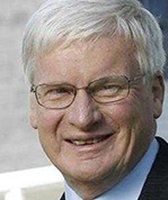Stand up for the facts!
Our only agenda is to publish the truth so you can be an informed participant in democracy.
We need your help.
I would like to contribute
GOP Wisconsin state senator says study shows kids living with parent and parent's partner "20 times" more likely to be sexually abused
The tasks of Wisconsin’s Child Abuse and Neglect Prevention Board include raising public awareness about the mistreatment of children.
Under a bill introduced in February 2012 by state Sen. Glenn Grothman, R-West Bend, the board would be required to "emphasize non-marital parenthood as a contributing factor to child abuse and neglect."
That’s a reference to homes where a child lives with a biological parent and the parent’s boyfriend or girlfriend.
The "non-marital parenthood" focus of the bill attracted national news coverage from CNN and the Huffington Post. It also drew criticism from advocates of single parents such as liberal talk show host Alan Colmes.
During his national Fox News radio program on March 2, 2012, Colmes asked Grothman to explain the bill.
"We do have a child abuse and neglect board and their goal is to educate people on how to reduce abuse," Grothman replied.
"Now the studies show that, if you are living with your two biological parents compared to with a biological parent and a boyfriend or girlfriend -- if you were with that boyfriend or girlfriend, you have a 20 times greater chance of being sexually abused."
Grothman went on to say that "people certainly know there are single moms who are good parents and there are single moms who aren’t. But when the statistics show you’re 20 times greater -- in one type of family structure than another -- to cause a child to be a victim of sexual abuse, it’s something that ought to be out there."
We decided to take a look at Grothman’s numbers.
Grothman’s evidence
Although he said "studies," Grothman made it clear to Colmes that the statistic he cited is from a U.S. Department of Health and Human Services study on child abuse and neglect published in January 2010. Mandated by Congress, the study "serves as the nation’s needs assessment on child abuse and neglect" and is the fourth in a series that dates back to the 1970s.
The newest study surveyed child protective service agencies in a representative sample of 122 counties about abuse and neglect cases they investigated during a one-year period -- the second half of 2005 and the first half of 2006. The study also obtained information about children who were identified by professionals as having been abused or neglected but whose cases were not officially investigated.
A major difference was found among perpetrators of different types of abuse. More than 70 percent of children who were physically or emotionally abused were abused by a biological parent, but only 36 percent of children who were sexually abused were sexually abused by a biological parent.
As for Grothman’s claim, Grothman aide Lance Burri cited a chart in the study on the rate of sexual abuse in different types of households.
The chart shows that children living with two married biological parents were sexually abused at a rate of 0.5 per 1,000 children, while the rate for children living with a single parent with a partner in the home was 9.9 per 1,000 children.
That means the sexual abuse rate for children living with a single parent who has a partner in the home was 19.8 times higher than the rate for children living with biological parents who are married.
So, by saying the rate is 20 times higher, Grothman is correct, a point we confirmed with the study's lead author, Andrea Sedlak. She noted that the study did not determine who the perpetrator was in the cases where children who were sexually abused were living with a parent and the parent's partner.
We would also note that the sexual abuse rate wasn’t higher in all types of single-parent homes. The same chart Grothman cited shows the rate among children living with a single parent who had no cohabiting partner (2.4 per 1,000 children) was lower than that of children living with other married parents, such as a biological parent and a stepparent (4.3 per 1,000 children).
Other viewpoints
We asked Ken Taylor, executive director of the nonprofit Wisconsin Council on Children & Families, about Grothman’s claim. His group is one of three that lobbied against Grothman’s bill.
Taylor said that while Grothman accurately quotes the study, a child living with a single parent and the parent's boyfriend or girlfriend is only one of many risk factors associated with abuse and neglect generally. Others include poverty, an adult’s substance abuse or mental illness, and whether the adult was abused as a child, he said.
The Wisconsin Coalition Against Domestic Violence, which also opposed Grothman’s bill, testified at a hearing on the bill that promoting marriage over single parenthood could put children at greater risk if there is domestic violence in a home with married parents. Conversely, promoting the reduction of substance abuse among adults, for example, would have only a positive impact on child abuse and neglect, the coalition said.
The Legislature didn’t act on Grothman’s bill before adjourning its session in March 2012. That means the bill would have to be re-introduced to be considered and Grothman hasn’t made a decision about doing that, his aide said. But the bill’s statement -- that "non-marital parenthood" is a "contributing factor to child abuse and neglect" -- is supported by the study.
The overall rate of abuse and neglect was lowest in homes with married biological parents -- 6.8 per 1,000 children. It was highest for children living with one parent who had an unmarried partner in the household -- 57.2 per 1,000 children. That’s more than eight times higher than the rate in households with married biological parents.
Our rating
Grothman said a federal study shows that children who live with a biological parent and the parent's boyfriend or girlfriend "have a 20 times greater chance of being sexually abused."
Grothman accurately quotes the study, which found that the rate of sexual abuse among children who live with a biological parent and the parent's partner is 20 times higher than the rate for children who live with their married biological parents.
We rate his statement True.
Our Sources
Fox News, Alan Colmes radio interview of Sen. Glenn Grothman, March 2, 2012
U.S. Department of Health and Human Services, Fourth national incidence study of child abuse and neglect, January 2010
Interview and email interview, Sen. Glenn Grothman aide Lance Burri, March 12 and 20, 2012
Interview, Sen. Glenn Grothman, March 20, 2012
Wisconsin Legislature, Senate Bill 507
Interview, Wisconsin Coalition Against Sexual Assault director of legal and systems services Ian Henderson, March 19, 2012
Interview, Wisconsin Council on Children & Families executive director Ken Taylor, March 19 and 20, 2012
Wisconsin Coalition Against Domestic Violence, Senate Bill 507 testimony, Feb. 29, 2012
Email interview, federal study author Andrea Sedlak, March 20, 2012
Browse the Truth-O-Meter
More by Tom Kertscher
GOP Wisconsin state senator says study shows kids living with parent and parent's partner "20 times" more likely to be sexually abused
Support independent fact-checking.
Become a member!
In a world of wild talk and fake news, help us stand up for the facts.




























